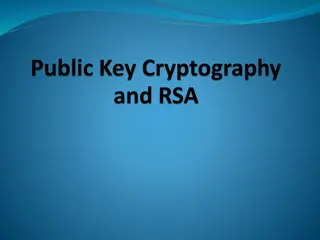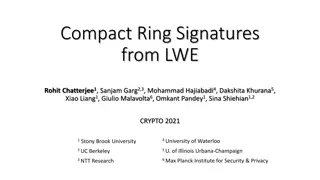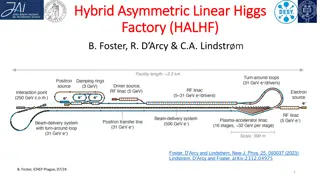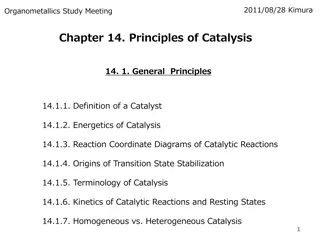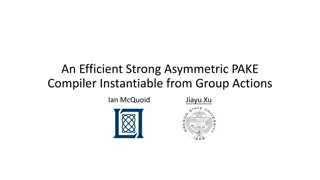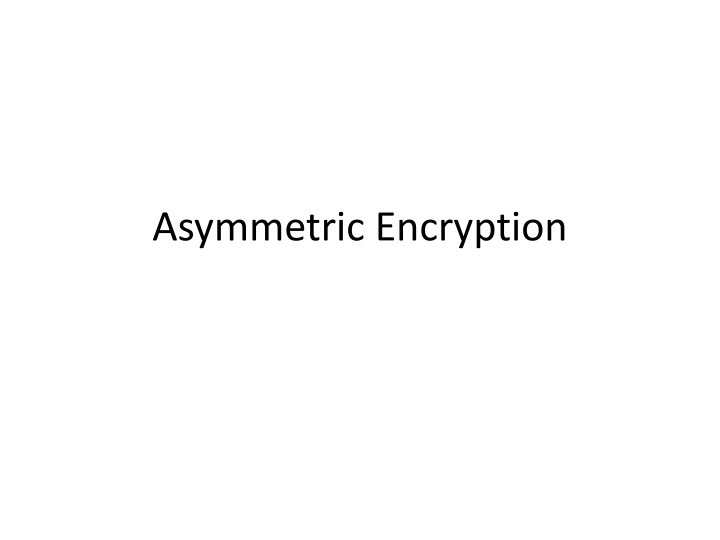
Asymmetric Encryption: Diffie-Hellman Key Exchange Explained
Explore the world of asymmetric encryption through the captivating concept of the Diffie-Hellman key exchange protocol. Delve into the intricacies of public-key cryptography, secret key agreement, and the mathematical foundations that make this encryption method secure and reliable.
Download Presentation

Please find below an Image/Link to download the presentation.
The content on the website is provided AS IS for your information and personal use only. It may not be sold, licensed, or shared on other websites without obtaining consent from the author. If you encounter any issues during the download, it is possible that the publisher has removed the file from their server.
You are allowed to download the files provided on this website for personal or commercial use, subject to the condition that they are used lawfully. All files are the property of their respective owners.
The content on the website is provided AS IS for your information and personal use only. It may not be sold, licensed, or shared on other websites without obtaining consent from the author.
E N D
Presentation Transcript
Announcements Essay due Next homework crypto (on paper) This week: more on encryption and authentication, then on to access control
Last time: symmetric key cryptography Based on shared knowledge of a private key BUT: protocol itself is not generally kept secret Very secure: For example, a 128-bit key in AES would take roughly 1 billion billion (est. 1.02 * 1018) years to crack on a 2012 supercomputer Simple and easy to implement XORs, etc
Asymmetric key cryptography Also known as public key cryptography Alice publishes something openly Bob can then send messages to Alice using this public key Huge and recent development New directions in cryptography , by Diffie and Hellman, 1976 Daily conspiracy tidbit: Actually developed by UK government researchers in secret in 1973
Diffie-Hellman key exchange Based on Zpwhere p is either prime or a power of a prime (qkwith q prime) We saw last time that Zpis a finite field: Nice + and * operations Has multiplicative inverses, as well: Take 2x = 1 mod 5 What is x?
The Diffie-Hellman protocol Consider p prime, and s < p (both public) Privately, Alice chooses a < p and Bob chooses b < p Alice computes A = samod p and posts it Bob computes B = sbmod p and posts it Alice computes the secret key Ba Bob computes the secret key Ab Claim: Ba= Ab, so they agree on a common secret key
Example: Let s = 2, p = 29 Alice likes a = 3 Bob likes b = 7
Why does this work? The common key is k = sabmod p Recap: public info is p, s, A = sa, and B = sb a, b, and k are all private What can an attacker do?
Hardness At its base, the key to why this is hard is something called the discrete logarithm problem. Remember logarithms? Log101000 = ? Log21024 = ? Here, we want discrete logs: given A, find logsA = logssa= a, all modulo p
The discrete log problem This is a problem that we think is hard Similar to factoring Note that there ARE ways to attack this it is not NP-Hard, but there are no known fast algorithms Stronger generalizations work in groups other than Zp, like something called elliptic curves A bit beyond this course, though
Beyond Diffie-Hellman Shortly after this protocol first came out, RSA was first released Stronger in many ways: it can be used to encrypt messages However, it usually isn t! Slower than symmetric key encryption Easier to attack RSA is also built on hardness of factoring numbers (Note: I m going over RSA the algorithm, not RSA the company they are different)
RSA: General overview Alice looks up Bob s public key, EB, in a directory Alice uses a known algorithm to encode a message m, resulting in EB(m) Bob then uses his private key DBto decode, so that DB(EB(m)) = m Idea: Alice can only give away m and EB(m), but no one else can decode without DB
How? Number theory! Definition: The Euler phi function (n) is defined as the number of integers less than n that are relatively prime to n Examples: (7) = ? (6) = ?
Phi function Lemma: If p is prime, then (p) = p-1 Lemma: If p and q are both prime, then (p*q) = (p)* (q) = (p-1)(q-1) Sketch of proof: What are p*q s factors?
Eulers Theorem Theorem: If a and n positive integers with a relatively prime to n (so that gcd(a,n) = 1), then a (n) = 1 mod n Example: Let n = 7 and a = 3: Another: Let n = 12 and a=5:
Eulers Theorem Why should we care? Inverses! a and a (n)-1 will be inverses to each other modulo n So if a is relatively prime to n, then there exists some b such that ab = 1 mod n Just set b = a (n)-1 A corollary: xymod n = xy mod (n)mod n
RSA (Rivest Shamir Adelmann) 1978 Bob generates two primes p and q Computes n = p*q and (n) = (p-1)(q-1) Bob then picks e relatively prime to (n) and finds a d such that e*d = 1 mod (n) He can do this, because he knows (n) use Euclidean algorithm d is now DB, Bob s private key (e,n) are his public key Essentially can forget about p,q, and (n)
RSA: encrypting Now go to Alice, who has a message m, as well as e and n To encrypt, Alice computes C = memod n and sends C to Bob Bob then takes C and computes Cdmod n Claim: M = Cdmod n Why?
RSA: double check Well: Cdmod n = (Me)dmod n = Medmod n One way to see it: Euler s Theorem corollary can take exponent mod (n): xymod n = xy mod (n)mod n So, here: Medmod n = Med mod (n)mod n = M1mod n = M. Another way: know ed = 1 mod (n), so (by definition) have ed = 1 + k (n) for some value k Then Med= M1+k (n)mod n = M1+ Mk (n)mod n, and M (n)= 1 mod n
RSA: double check Catch need M relatively prime to n. Likely to be true, but we still want it to work Luckily, still works if not relatively prime! We know it is still relatively prime to either p or q, since both are prime. (Math is a bit more complex, but not hard to walk through the equations.)
The security of RSA Public knowledge: (e,n) How hard is it to get d? Recall: d is the value that is d s inverse mod (n) This is easy if you know (n) Use the extended Euclidean algorithm How can you get (n) from (e,n)? Answer: factoring! Pretty good, though: no 512 bit number has yet been factored (I think )
Cautions There are a lot of attacks on RSA Some examples: Don t choose bad values of n: easier to factor sometimes, especially if n isn t big enough Franklin-Reiter related message attack: If messages are related for example, M1= f(M2) for some polynomial f then original messages can be recovered Many more, depending on implementation. In fact, textbook RSA, which we just went through, is considered insecure
Improvements: Elgamal The Elgamel cryptosystem (named after its inventor) adds randomness to the basic structure of RSA Result: encrypting the same message will give a different cipher text Alice will need a different random number each time, though, or won t be more secure Nicely set up: encryptor (Alice) doesn t need to know secret key, and decryptor (Bob) won t need to know the random value Alice does need to send two things instead of one, but result is much more secure
Hashing Cryptographic hash functions are functions that take an input and return a fixed size alphanumeric string, call the hash value Also message digest, digital fingerprint, digest, and checksum Often used as signatures: provides reason to believe message has not been changed Also passwords, etc. Outside of security world also!
Goals of a hash Some things are unchanged from data structures! Goals of hash function: Easy to calculate Computationally difficult to calculate an input text that would generate any given hash output Extremely unlikely that two different message would give the same hash Essentially, these are deterministic functions that somehow behave randomly
Hashing standards NIST also had a call to standardize modern hashes, in 2007 Results: 3 different algorithms SHA (with a number at the end) SHA-256 employs a compression function with inputs of size 512 bits and outputs 256 bits SHA-512 takes 1024 and outputs 512 MD5 is sometimes also used, but is widely considered to be insecure Known attack where given two messages, one can compute two suffixes such that they collide Result: can compute (for example) different PDF files with the same hash
Takeaway message As a programmer or user of cryptography, you should know the major packages! NSA Suite B is modern standard: Encryption: AES Signatures: Elliptic curves Diffie-Hellman: variant of Diffie-Hellman that uses those elliptic curve groups I briefly mentioned last week Hashing: SHA
Note: no RSA! Yet RSA is the most widely used in the transport layer This is where website traffic lives, and we ll talk more about it later in the course Why??
Why RSA? RSA is used in websites, smart cards, at the OS level, and in many other places Main reasons: speed, cost, legacy issues, etc.











